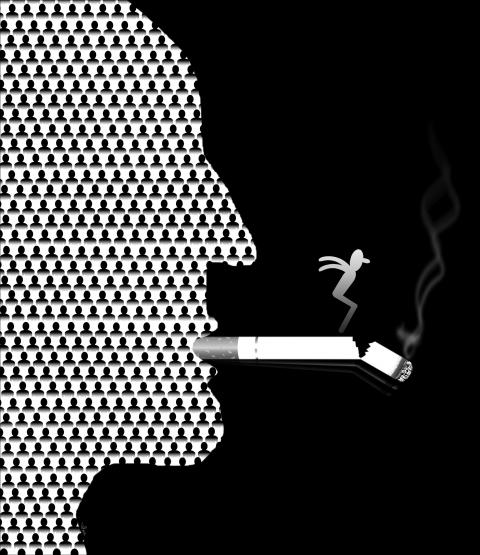US President Barack Obama’s doctor confirmed last month that the president no longer smokes. At the urging of his wife, Michelle Obama, the president first resolved to stop smoking in 2006 and has used nicotine replacement therapy to help him. If it took Obama, a man strong-willed enough to aspire to and achieve the US presidency, five years to kick the habit, it is not surprising that hundreds of millions of smokers find themselves unable to quit.
Although smoking has fallen sharply in the US, from about 40 percent of the population in 1970 to only 20 percent today, the proportion of smokers stopped dropping around 2004. There are still 46 million US adult smokers, and smoking kills about 443,000 Americans each year. Worldwide, the number of cigarettes sold — 6 trillion a year, enough to reach the sun and back — is at an all-time high. Six million people die each year from smoking — more than from AIDS, malaria and traffic accidents combined. Of the 1.3 billion Chinese, more than one in 10 will die from smoking.
Earlier this month, the US Food and Drug Administration (FDA) announced that it would spend US$600 million over five years to educate the public about the dangers of tobacco use. However, Robert Proctor, a historian of science at Stanford University and the author of a book coming out in January entitled Golden Holocaust: Origins of the Cigarette Catastrophe and the Case for Abolition, argues that to use education as one’s only weapon against a highly addictive and often lethal drug is unpardonably insufficient.

“Tobacco control policy too often centers on educating the public, when it should be focused on fixing or eliminating the product,” he says
Proctor points out that we don’t just educate parents to keep toys painted with lead-based paints away from their children’s mouths; we ban the use of lead-based paint. Similarly, when thalidomide was found to cause major birth defects, we did not just educate women to avoid using the drug when pregnant.
Proctor calls on the FDA to use its new powers to regulate the contents of cigarette smoke to do two things. First, because cigarettes are designed to create and maintain addiction, the FDA should limit the amount of nicotine that they contain to a level at which they would cease to be addictive. Smokers who want to quit would then find it easier to do so.
Second, the FDA should bear history in mind. The first smokers did not inhale tobacco smoke; that became possible only in the 19th century, when a new way of curing tobacco made the smoke less alkaline. That tragic discovery is already responsible for about 150 million deaths, with many times that toll still to come, unless something drastic is done. The FDA should therefore require that cigarette smoke be more alkaline, which would make it less easily inhaled, and so make it harder for cigarette smoke to reach the lungs.
Much of Proctor’s book is based on a vast archive of tobacco-industry documents, released during litigation. More than 70 million pages of industry documents are now available online.
The documents show that, as early as the 1940s, the industry had evidence suggesting that smoking causes cancer. In 1953, however, a meeting of the chief executives of major US tobacco companies took a joint decision to deny that cigarettes are harmful. Moreover, once the scientific evidence that smoking causes cancer became public, the industry tried to create the impression that the science was inconclusive, in much the same way that those who deny that human activities are causing climate change deliberately distort the science today.
As Proctor says, cigarettes, not guns or bombs, are the deadliest artifacts in the history of civilization. If we want to save lives and improve health, nothing else that is readily achievable would be as effective as an international ban on the sale of cigarettes. (Eliminating extreme poverty worldwide is about the only strategy that might save more lives, but it would be far more difficult to accomplish.)
For those who recognize the state’s right to ban recreational drugs like marijuana and ecstasy, a ban on cigarettes should be easy to accept. Tobacco kills far more people than these drugs.
Some argue that as long as a drug harms only those who choose to use it, the state should let individuals make their own decisions, limiting its role to ensuring that users are informed of the risks that they are running. However, tobacco is not such a drug, given the dangers posed by secondhand smoke, especially when adults smoke in a home with young children.
Even setting aside the harm that smokers inflict on nonsmokers, the free-to-choose argument is unconvincing with a drug as highly addictive as tobacco, and it becomes even more dubious when we consider that most smokers take up the habit as teenagers and later want to quit. Reducing the amount of nicotine in cigarette smoke to a level that was not addictive might meet this objection.
The other argument for the status quo is that a ban on tobacco might result in the same kind of fiasco as occurred during Prohibition in the US. That is, like the effort to ban alcohol, prohibiting the sale of tobacco would funnel billions of dollars into organized crime and fuel corruption in law-enforcement agencies, while doing little to reduce smoking.
However, that may well be a false comparison. After all, many smokers would actually like to see cigarettes banned because, like Obama, they want to quit.
Peter Singer is a professor of bioethics at Princeton University and laureate professor at the University of Melbourne.
Copyright: Project Syndicate
Lockheed Martin on Tuesday responded to concerns over delayed shipments of F-16V Block 70 jets, saying it had added extra shifts on its production lines to accelerate progress. The Ministry of National Defense on Monday said that delivery of all 66 F-16V Block 70 jets — originally expected by the end of next year — would be pushed back due to production line relocations and global supply chain disruptions. Minister of National Defense Wellington Koo (顧立雄) said that Taiwan and the US are working to resolve the delays, adding that 50 of the aircraft are in production, with 10 scheduled for flight

Victory in conflict requires mastery of two “balances”: First, the balance of power, and second, the balance of error, or making sure that you do not make the most mistakes, thus helping your enemy’s victory. The Chinese Communist Party (CCP) has made a decisive and potentially fatal error by making an enemy of the Jewish Nation, centered today in the State of Israel but historically one of the great civilizations extending back at least 3,000 years. Mind you, no Israeli leader has ever publicly declared that “China is our enemy,” but on October 28, 2025, self-described Chinese People’s Armed Police (PAP) propaganda
On Sunday, 13 new urgent care centers (UCC) officially began operations across the six special municipalities. The purpose of the centers — which are open from 8am to midnight on Sundays and national holidays — is to reduce congestion in hospital emergency rooms, especially during the nine-day Lunar New Year holiday next year. It remains to be seen how effective these centers would be. For one, it is difficult for people to judge for themselves whether their condition warrants visiting a major hospital or a UCC — long-term public education and health promotions are necessary. Second, many emergency departments acknowledge
Chinese Consul General in Osaka Xue Jian (薛劍) on Saturday last week shared a news article on social media about Japanese Prime Minister Sanae Takaichi’s remarks on Taiwan, adding that “the dirty neck that sticks itself in must be cut off.” The previous day in the Japanese House of Representatives, Takaichi said that a Chinese attack on Taiwan could constitute “a situation threatening Japan’s survival,” a reference to a legal legal term introduced in 2015 that allows the prime minister to deploy the Japan Self-Defense Forces. The violent nature of Xue’s comments is notable in that it came from a diplomat,